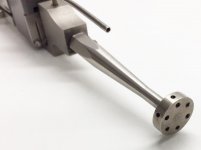SolidWorksBest
Plastic
- Joined
- Feb 22, 2022
Greetings to all. This is my first post. I've read & scrolled on this site for many years, finally decided to join. The pool of knowledge here is refreshing, much respect to all. May I ask, can anyone please help identify this tool? It belongs to a neighbor of mine, he asked me and I just can't figure it out. There are no markings on it, no part numbers and no brand name. It's roughly 9-1/4" long, the disc/tip at the base is 5/8" OD and around .170" thick.
If any other info is needed, please let me know.
Thank you to all in advance
My very best
Gerhard
If any other info is needed, please let me know.
Thank you to all in advance
My very best
Gerhard





